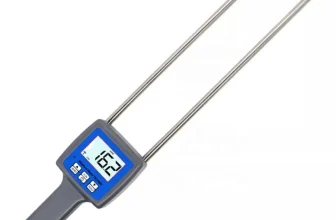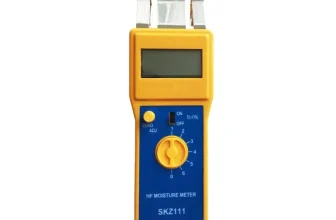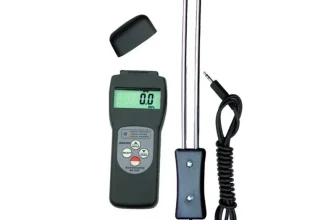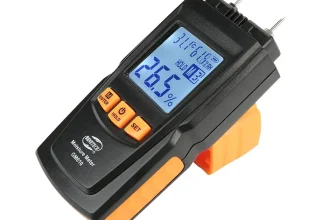A moisture meter is a hand-held device designed to measure the amount
of moisture in various materials. These versatile tools are
indispensable across multiple industries, with uses that span from
construction to agriculture, woodworking to paper production. With its
roots harking back to the 1930s, the moisture meter’s purpose is to
provide accurate readings of moisture content, which assists users in
moments of critical decision making, quality control and preventative
maintenance. Belmont to the tool belt of both professionals and DIY
enthusiasts alike, understanding moisture levels can lead to efficiency,
quality assurance, and even the prevention of potential issues such as
mold growth and wood decay. With various types available, including pin,
pinless and all-in-one meters, there’s a suitable device for most
applications. In this article, we explore the moisture meter: its
function, applications, types, importance, and the factors to consider
when choosing one.
Importance in Different
Fields
The moisture meter is not limited to a single industry or
application. Its utility spans across a multitude of fields, making it
an impressive tool of great importance. In the construction and home
inspection industries, for instance, it plays a critical role in
detecting and preventing issues like mold growth and structural damage
caused by excessive moisture. It’s equally indispensable in agriculture
where it helps farmers maintain optimal soil moisture levels, thereby
improving crop health and yield. Even in paper production, furniture
making and woodworking, moisture meters are used to ensure the quality
of the materials and final products. This broad applicability makes the
moisture meter a tool of immense significance in different fields.
Basic Understanding
of the Moisture Meter
Definition of a Moisture
Meter
A moisture meter is a specialized tool that measures the percentage
of water in a particular substance. This instrument allows us to
determine if the material is ready for use, excessively moist, or at
risk of mold development. The moisture meter is designed to pinpoint the
moisture content using either intrusive probes or non-destructive
methods, with each method suitable for specific applications. Such
meters are commonly used on a wide variety of materials, including wood,
drywall, concrete, and other building and farming materials. In essence,
a moisture meter helps detect hidden water damage and prevent problems
associated with excess moisture.
How the Device Works
A moisture meter works based on the principle that moisture affects
the way in which materials conduct electricity. The device measures the
resistance or conductivity that exists between two points, making use of
two or more electrodes (in case of pin-type meters). When the meter is
placed against the material, an electrical current is passed through
from one point to another. The more moisture contained within the
material, the less resistance there will be, resulting in an increased
conductivity.
Pinless moisture meter, on the other hand, works by emitting
electromagnetic waves into the material and measuring the response. The
level of moisture is quantified based on the variations in the measured
field.
The meter then translates these readings into moisture content
percentage and displays it on the screen, which can provide immediate
and accurate information regarding the moisture level within the tested
material. Diverse moisture meters are calibrated for different
materials, ensuring more precise measurements. This principle is what
allows a moisture meter to function accurately across a wide range of
materials such as wood, concrete, drywall, and more.
Types of Moisture Meters
Pin Moisture Meters
Pin moisture meters are one of the three primary types of moisture
detection devices you can find in the market. As the name implies, they
employ the use of two or more pins which are pushed into the material
you want to measure. The moisture content is then determined based on
the electrical resistance measured between these pins. As the principle
follows that the higher the moisture content, the lower the resistance,
it gives a clear and quantifiable measure of the moisture present.
One significant advantage of pin moisture meters is their ability to
measure moisture content at a variety of depths, dependent on the length
of the pins, which makes them highly versatile in their usage. However,
a caveat to be mindful of is potential damage to the surface of the
material being tested due to pin insertion. Consequently, pin moisture
meters are most appropriate for use in applications where the surface
condition of the material is not of utmost importance.
Pinless Moisture Meters
Pinless moisture meters, also known as non-destructive or
non-invasive moisture meters, are used for detecting moisture levels
without damaging the material surface. These gadgets use high-frequency
signals or electromagnetic fields to probe beneath the surface of the
material, delivering immediate moisture readings.
Designed with a flat sensor pad, pinless moisture meters need to be
placed directly onto the surface of the material for effective
measurements. When done correctly, they can provide moisture content
data for a larger measurement area compared to pin meters, making them
ideal for detecting moisture in broad surfaces quickly
One of the biggest advantages of pinless meters is that they leave no
trace of measurement, preserving the aesthetic quality of delicate
materials like polished wood or antique furniture. However, their
readings can be influenced by the material’s density or thickness, and
they might not be as effective in detecting moisture pockets deep within
the material.
All-in-One Moisture Meters
All-in-One Moisture Meters are the most versatile form of moisture
detection devices. As the name suggests, this type of meter combines the
functionality of pin and pinless moisture meters into a single unit.
This makes them a suitable choice for a broad range of applications,
offering the flexibility to switch between modes according to your
requirements.
All-in-One Moisture Meters are equipped with non-invasive sensors
that can measure moisture content without damaging the surface, and
prongs that can aid in detecting deeper moisture within the material.
With this, users can easily identify the moisture levels in different
locations and depths of a material.
Due to its increased functionality, an All-in-One Moisture Meter
tends to be more expensive than the other types. However, their high
accuracy, versatility and the convenience of having both types of meters
in one make them a valuable tool for professionals across various
industries.
Applications of the Moisture
Meter
In Construction and Home
Inspections
Moisture meters play a significant role in the construction industry
and home inspection scenarios. They are commonly used to detect hidden
issues like water leaks or damage that might not be readily noticeable
by visual inspection alone. For instance, prior work performed in walls
or floors, including insulation, plumbing, or electrical installation,
can possibly hide water damage from view.
Moisture meters help by providing quantitative and accurate
measurements of moisture content. This is crucial when inspecting
properties for sale or rent, as potential issues like mold growth or
structural damages caused by excessive moisture can be identified before
the transaction.
When used in construction, they can help to ensure that the materials
being used are in proper condition. For example, before installing
drywall or flooring materials, they can help verify that the underlying
wood framing and subfloor are dry and free from potentially damaging
moisture.
Utilized correctly, moisture meters in construction and home
inspections can lead to improved work quality, prevention of future
issues, and overall increase in client satisfaction.
In Agriculture
Agriculture is a predominant field in which moisture meters are
extensively used. The maintenance of correct moisture levels is crucial
in agricultural practices, from sowing seeds to the final yield. A
moisture meter helps farmers determine the water content in the soil,
enabling them to make informed decisions about irrigation schedules.
This device can directly affect crop yield by preventing
over-irrigation and under-watering, both of which can be detrimental to
plant health. Additionally, moisture meters help farmers manage
irrigation more efficiently, thereby conserving water.
Moreover, farmers also use moisture meters to measure the water
content in harvested crops such as grains, cereals, hay, and silage. Too
much moisture in harvested crops can lead to problems like mold growth
and spoilage, while too little can increase the risk of loss during
processing and storage. The device helps to ensure that harvested crops
are dried down to the ideal moisture content before being stored, which
is a critical factor in preserving crop quality and reducing losses.
Therefore, moisture meters not only contribute to more effective
farming practices but also facilitate the preservation and preparation
of harvested produce, underlining their importance in agriculture.
In Woodworking and
Furniture Making
Woodworking and furniture making immensely benefit from the use of
moisture meters. Understanding the moisture level of wood is essential
in these sectors as the moisture content significantly determines its
quality, durability, and final use.
When making furniture or crafting wooden structures, the wood’s
moisture content should ideally be in equilibrium with the surrounding
atmosphere’s moisture level. Too much moisture, and the wood could warp
or crack as it dries. Too little, and it might swell if the humidity in
the environment increases. Having the correct moisture measurement can
ultimately make the difference between a durable, beautiful piece and
one that distorts over time.
Moisture meters come in handy during various stages of woodworking
and furniture making. During the initial wood selection, craftsmen can
use these devices to discern between different pieces, opting for those
with appropriate moisture levels. After the crafting process, a moisture
meter can confirm if the wood is ready for finishing or needs more
drying time.
Therefore, a moisture meter is an indispensable tool in woodworking
and furniture making industries, ensuring the delivery of quality and
durable wooden items.
In Paper Production
Moisture plays a key role in the paper production industry. Paper, by
nature, is hygroscopic – absorbing or attracting moisture from the
environment, which can significantly affect its production, quality, and
end use.
With a moisture meter, paper manufacturers can accurately measure the
moisture content during different stages of the paper production
process. During the initial production phase where the paper pulp is
processed and dried, managing the moisture content is crucial to achieve
the right consistency and prevent any production issues. A lower
moisture level might make the paper brittle and susceptible to tearing,
while a higher level can cause issues such as ink bleeding during
printing.
The moisture meter is also beneficial in the quality control phase.
By keeping a constant check on the moisture levels, manufacturers can
ensure uniformity and quality in their product. The correct moisture
content guarantees that the paper will not curl, warp, or have other
structural problems.
Managing moisture is also essential during the storage and shipping
of paper products. It helps prevent the paper from getting damp and thus
avoids possible mold growth and other damage. Moisture meters aid in
determining the optimal storage conditions, helping to maintain the
paper’s quality until it reaches the end user.
In conclusion, a moisture meter plays an invaluable role in the paper
production industry, ensuring efficiency, maintaining quality, and
minimizing wastage.
In Other Industries
Aside from the industries already discussed, moisture meters also
find significant application in a variety of other commercial settings.
In the textile industry, for instance, they help in determining the
moisture content in fabrics and yarns, which can impact their color,
strength, and shrinkage characteristics. This ensures the quality of the
final product and increases efficiency in the manufacturing process.
In the pharmaceutical industry, moisture meters play a crucial role
in ensuring the quality of drugs. Excessive moisture in pharmaceutical
products can lead to degradation, decreased effectiveness, and short
storage life. Thus, ensuring precise control over the moisture levels
allows manufacturers to deliver safe and effective medication.
The food and beverage industry also relies heavily on moisture
meters. From meat to grains, the moisture content can significantly
affect the taste, texture, shelf life, and nutritional value. Moreover,
in breweries and distilleries, they help achieve the right balance of
water in the brewing and distilling processes.
In the realm of cosmetic manufacturing too, maintaining the optimal
level of water in products helps in preserving their texture, color, and
shelf life. Due to this, moisture meters have become an indispensable
tool.
The list goes on, encompassing industries like leather production,
tobacco processing, oil and gas, etc., emphasizing the versatile and
significant utility of moisture meters across several distinct
sectors.
Factors to
Consider When Choosing a Moisture Meter
Range of Moisture Content
The range of moisture content is a key factor to examine when
selecting a moisture meter. This parameter indicates the amount of
moisture that the device can detect in a given substance or
material.
Some materials naturally have a higher moisture content than others.
For example, freshly cut wood can have a moisture content as high as
50%, while drywall and other construction materials typically have much
lower moisture ratios. Therefore, the ideal moisture meter for you would
depend on the specific materials you plan to measure.
Most moisture meters have a moisture content range from 0% to 100%,
but the optimal range for wood is typically 5% to 40%, and for building
materials is often 0.2% to 2.5%. As such, getting a moisture meter with
an appropriate range for your specific application can ensure more
accurate and effective readings.
A meter with a wide moisture range allows for versatility as it can
be used across different materials, making it a good choice if you plan
to use it for diverse applications. Alternatively, if you’re just
interested in one specific material, a moisture meter designed for that
material’s typical moisture range can offer a more specialized, precise
measurement.
In essence, understanding the natural moisture content of the
materials you will be testing and the range of your chosen meter
significantly impacts the accuracy and effectiveness of your moisture
detection.
Sensing Depth
Sensing depth is another critical factor to consider when selecting a
moisture meter. Different materials and applications require different
sensing depths. For example, if you’re testing the moisture content in
lumber, you may need a meter that can penetrate deep into the wood,
whereas if you’re testing a thin piece of paper, a lower depth would
suffice.
Sensing depth is also tied to the type of moisture meter you choose.
Pin-type moisture meters can measure moisture up to the depth of the
pins, making them suitable for checking through drywall or thick wood.
Pinless models, on the other hand, come with a set sensing depth
typically ranging between 1/4 inch to 3/4 inch below the surface.
It’s important to note that using a moisture meter with the incorrect
sensing depth can lead to inaccurate results and potential damage to the
material. Therefore, before purchasing a moisture meter, have a clear
understanding of the sensing depth compatible with the materials you
will be typically testing.
Ease of Use
Ease of Use is another factor that should be taken into account when
selecting a moisture meter. Moisture meters come with varying levels of
complexity, some featuring digital screens with simple readouts while
others offer more advanced features like Bluetooth integration or the
capacity to store and save data for later analysis.
A crucial aspect of the ‘Ease of Use’ is how straightforward it is to
read and understand the results provided by the device. A moisture meter
that provides clear, legible and quickly accessible readings makes the
job less time-consuming and can increase efficiency, especially in
business sectors where time is of essence.
Furthermore, pay attention to how easy it is to operate the device.
This includes factors such as weight, handheld comfort, and the easiness
to navigate through its interface or switch between different modes of
operation. If the device is too cumbersome or complicated, it could lead
to inaccurate measurements due to user error and frustration.
In summary, opt for a moisture meter that best suits your level of
expertise, and matches the ease, speed and adaptability required in your
line of work or personal use.
Accuracy
Accuracy is a vital factor when choosing a moisture meter. As the
purpose of using such a device is to obtain precise measurements of
moisture content, an inaccurate meter can result in false data, leading
to potential problems down the line. It’s important to ensure that the
device’s accuracy is within a reasonable tolerance for the specific
application it’s intended for. Some meters are designed for high-level
precision for industries such as construction and furniture making that
require excellent precision, while others have a broader range, suitable
for less-sensitive applications. Always remember to check the accuracy
specification of a moisture meter before purchase and use.
Price
The price of a moisture meter is a key consideration for many buyers.
These devices can range in cost from around $30 to several hundred
dollars. Basic moisture detectors without additional features can be
quite affordable, making them great for occasional use or for those on a
tighter budget. On the other hand, professional grade meters with more
intricate features and high accuracy come with a higher price tag. The
individual requirements and frequency of use should dictate which price
point and model you opt for. Remember that investing in a more expensive
moisture meter may result in long-term savings, owing to better product
quality, prevention of potential damages, and optimization of storage
conditions.
Importance of Using a
Moisture Meter
Prevention of Mold and Decay
Moisture meters play a key role in the prevention of mold and decay,
conditions that often occur due to excessive dampness. Wet, damp
conditions serve as the perfect breeding ground for mold, leading to
potential health risks and damage to buildings, crops, or products. The
use of a moisture meter allows individuals to detect hidden moisture
content that might not be visibly apparent. In turn, this early
detection provides a window of opportunity to address the moisture issue
before it escalates into a mold or decay problem. Ensuring correct
moisture levels not only safeguards health but also preserves the
integrity of materials, be it in a house, a furniture piece or in an
agricultural field.
Ensures Product Quality
Moisture meters have an integral role in securing the quality of
various products. In woodworking, for instance, excessive moisture can
cause swelling, warping, or even rot which can depreciate the quality
and lifespan of wooden products like furniture. By using a moisture
meter, craftsmen can ensure that the wood they are using is of the
correct moisture content, thereby enhancing the durability and aesthetic
appeal of the final product.
In industries like agriculture, the use of a moisture meter can
facilitate optimal harvesting times, substantiate the quality of crops,
and aid in determining adequate storage conditions. When used in the
food industry, moisture meters help maintain the desired product
consistency, which is crucial for product quality and customer
satisfaction.
Furthermore, in the construction industry, a moisture meter is used
to ascertain the water content in materials like concrete and wood. Too
much moisture can compromise the structural integrity of buildings,
causing issues like dampness, mold, and even structural failure in
severe cases. Therefore, the use of moisture meters in this field is
crucial to certify the safety and quality of structures.
Hence, from consumer goods to large-scale constructions, moisture
meters significantly contribute to ensuring the quality of numerous
products across a range of industries.
Aids in Proper Storage
Conditions
Proper storage conditions are crucial in many areas, particularly in
agriculture, woodworking, and construction, where the materials’
moisture content significantly influences their quality, usability, and
lifespan.
A moisture meter plays an essential role in ensuring adequate storage
conditions. By providing accurate moisture readings, these devices allow
for the assessment of whether the environment is suitable for the stored
materials or products.
For instance, agricultural products like grains must maintain a
specific moisture range while in storage. Too much moisture can foster
the growth of fungi or bacteria, causing spoilage. On the other hand,
low moisture content could lead to unnecessary dryness and loss of
weight. The use of a moisture meter can help in regularly monitoring
these conditions.
Similarly, in the case of wood used for furniture or construction,
improper storage conditions can result in warping, cracking, or rotting.
Here, moisture meters can help by providing precise measurements,
allowing for the adjustment of storage conditions if necessary.
Thus, a moisture meter is an indispensable tool for safeguarding
materials against moisture damage, ensuring they are stored under
optimal conditions, which ultimately preserves their quality and extends
their durability.
Saves Money in the Long Run
Using a moisture meter can contribute significantly to long-term
financial savings. This comes into play in several ways. In the
construction industry, for instance, using a moisture meter can prevent
costly repairs stemming from hidden water damage or mold growth, both of
which are often results of excessive moisture. By accurately detecting
the moisture levels early on, necessary steps can be taken proactively
to rectify the issue, thereby avoiding exorbitant repair or replacement
costs in the future.
Similarly, in industries such as agriculture and woodworking,
ensuring appropriate moisture content can dramatically improve product
longevity. In agriculture, correct soil moisture levels are critical for
crop growth. Overly wet or dry conditions can negatively impact yield,
affecting the farmer’s yearly crop profitability. Meanwhile, in
woodworking, furniture or flooring crafted from wood with inappropriate
moisture content can warp or crack over time. The use of a moisture
meter guarantees the consistency of the final product, preventing
potential customer returns and maintaining brand credibility.
Hence, the use of a moisture meter is not just about maintaining
quality or preventing damage. It’s also a smart financial decision that
can save you significant amounts of money in the long run.
Conclusion
Recap of
the Importance and Uses of a Moisture Meter
The moisture meter, from its function to its diverse applications,
proves to be a valuable tool across various industries. Whether it’s for
construction inspections, agriculture, woodworking, paper production or
other industrial uses, its ability to accurately measure moisture
content plays a critical role in ensuring product quality, preventing
mold and decay, maintaining proper storage conditions, and ultimately
saving money in the long run.
Despite being a simple, easy-to-use tool, the impact it has on the
day-to-day operations of these fields is indisputable. It highlights the
importance of accurate moisture measurement not only in addressing
immediate concerns but also in avoiding potential problems down the
line.
Bearing this in mind, the correct usage and regular maintenance of
moisture meters should not be overlooked. Doing so can maximize its
functionality and longevity. In the end, no matter how technologically
advanced a tool may be, its effectiveness still largely depends on the
responsibility and awareness of the end-user. A moisture meter embodies
this principle; being not just a tool, but an investment towards
quality, safety, and efficiency.
Encouragement
for Proper Usage and Maintenance of the Device
It is vital for users to understand the necessity of proper usage and
regular upkeep of their moisture meter. Proper calibration, cleaning,
and storage practices can significantly contribute to the accuracy and
longevity of these devices, thereby saving money and ensuring reliable
results over the long term. It’s not just about owning a moisture meter,
it’s also about using it correctly and maintaining it well. By doing so,
you are leveraging technology to its fullest potential, enhancing your
productivity, and taking a proactive step in safeguarding a healthy and
safe environment. So take the time to familiarize yourself with your
tool, follow the manufacturer’s guidelines, and make regular maintenance
a habitual task. Keep in mind that a well-maintained moisture meter is a
valuable asset to whatever field you’re in.







